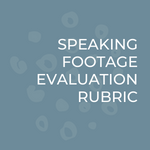Why you should watch your speaking footage

One of the most efficient and effective ways to improve your public speaking and presenting skills is to watch yourself on video. Much like athletes reviewing game film, studying your footage enables you to see yourself through the audience’s eyes. The goal is, as always, to meet their needs and make their experience better, so watching from their vantage point is the true gauge of your efficacy.
The boon of most presentations being delivered in a virtual format today is that our footage is readily available; most conferences and meetings are recorded for later viewing by those who couldn’t attend. No longer is capturing video an expensive or complicated effort for even the smallest presentation.
You might wince at the thought of watching yourself. (We don’t like to hear ourselves either; this TED talk explains why.) But if you’re wincing, that’s really just an indicator that you can improve. (And who can’t improve?)
How to improve your public speaking and presentation skills: Five steps to gain maximum benefit from reviewing your speaking footage.
1 Gather materials
Before you get started, grab some paper and a pen; be poised to take notes. (Or, download my free rubric for easy prompts.) Popcorn and Twizzlers are optional.
2 Watch without listening
Turn off the sound and press play. Just watch. Give it at least five minutes, 10 would be better. As you watch, look for the following:
- Eye contact with camera. Were you looking at the participants on screen or gazing directly into the camera? (Or, if you’re watching footage from a live event, look for times when you locked eyes with someone.)
- Facial expression. What happens when you pause for breath or thought? How does your face read? Open? Warm? Angry? Confused? What non-verbal message are you sending with your face?
- Posture. Are you standing (or sitting) tall and confident? What is the angle of your body to the camera? Your head to the camera? Do you cock your head in a particular direction–up, down, left or right? What might that body position be inadvertently communicating? Aim for head-on, eye-level.
- Unintentional, unnecessary body movement. Are you swaying or rocking, either side-to-side or forward and back? The latter can create a focus issue on web conferencing platforms and also amplifies aspects of your face intermittently (in an often unbecoming way). Do you fiddle with clothing or hair?
- Gestures. Are they congruent with your stage? Assuming it’s an online presentation, your gestures will need to fit inside the frame of view to fit with the scale of the virtual room.
- Lighting and backdrop. An in-person presenter doesn’t have control over these items, but when we’re presenting from home, we must take time to set up adequate lighting and ensure our backgrounds aren’t distracting from–and therefore interfering with–our message.
- Finally, take notes on any additional items that stand out as you watch. Confession: when I first watched a video of myself I noticed a habit of holding my elbows bent that made me look like I was flapping my wings like a chicken whenever I gestured. Super.

3 Listen without watching
Turn the sound back on but look away from the monitor and just process the audio of your speaking without being distracted by how you appear on camera. Again, give it five or 10 minutes. Listen for:
- Filler words. You might also call these “thinking words” because they’re used when thinking about what you plan to say next. Examples include the age-old “ums” and “uhs” but might be less common: “so” and “right.” Listen also for unnecessary repetitive phrases you default to (“if that makes sense” or “as they say”).
- Vocal variety. Do the tone and/or volume of your voice change to mirror the content? Are you audible? Variety is what keeps the brain engaged. (Bueller? Bueller?)
- Enunciation and pronunciation. Are your words clear and intelligible? Or are you getting sloppy and making your audience work hard to understand you? Consider asking a friend to listen alongside for this specific aspect as you may also be pronouncing words in an unusual way and not realize it; give them permission to point those out.
- Pacing. Are you speaking at a rate that the audience can follow along easily? Or are you rushed (because you’re nervous or running out of time) and talking too fast?
4 Identify what you want to work on first
Review your notes and assess which issues have the greatest adverse impact on your presentations–not more than three. Come up with a strategy to combat each (book a session with me if you’re not sure how to address it). Then, next time you’re preparing to give a talk, focus on one issue in each rehearsal. In other words, if you’re working on eliminating the word “like” and also trying to make more eye contact and smiling more, rehearse once focusing on eliminating the word, a second time working on eye contact, and a third time ensuring you’re smiling.
5 Re-evaluate at regular intervals
Review your footage again in a month or at some regular interval of your choosing. Use the same footage or new footage. Hold on to your notes from each evaluation as a way to appraise your progress. By continuously evaluating and practicing, you will improve. Once you’ve made sufficient progress in one area, shift your focus to the next area needing attention.
Public speaking and presenting are skills–not talents.
Skills can be improved upon and refined. That means you never need surrender to a fear of public speaking or feel defeated when it doesn’t go well. Take the opportunity to review the readily-available footage that the rise of virtual presentations has supplied. Even if you’re not scheduled to present soon, capture your own footage: simply start your own meeting on the platform of your choice and press record.
You’ve got this.

This post assumes you’ve done the hard work of crafting content and visual aids that truly achieve the goal of your talk. Without that effort, a well-delivered talk is just lipstick on a pig. Download my free evaluation rubric here.
